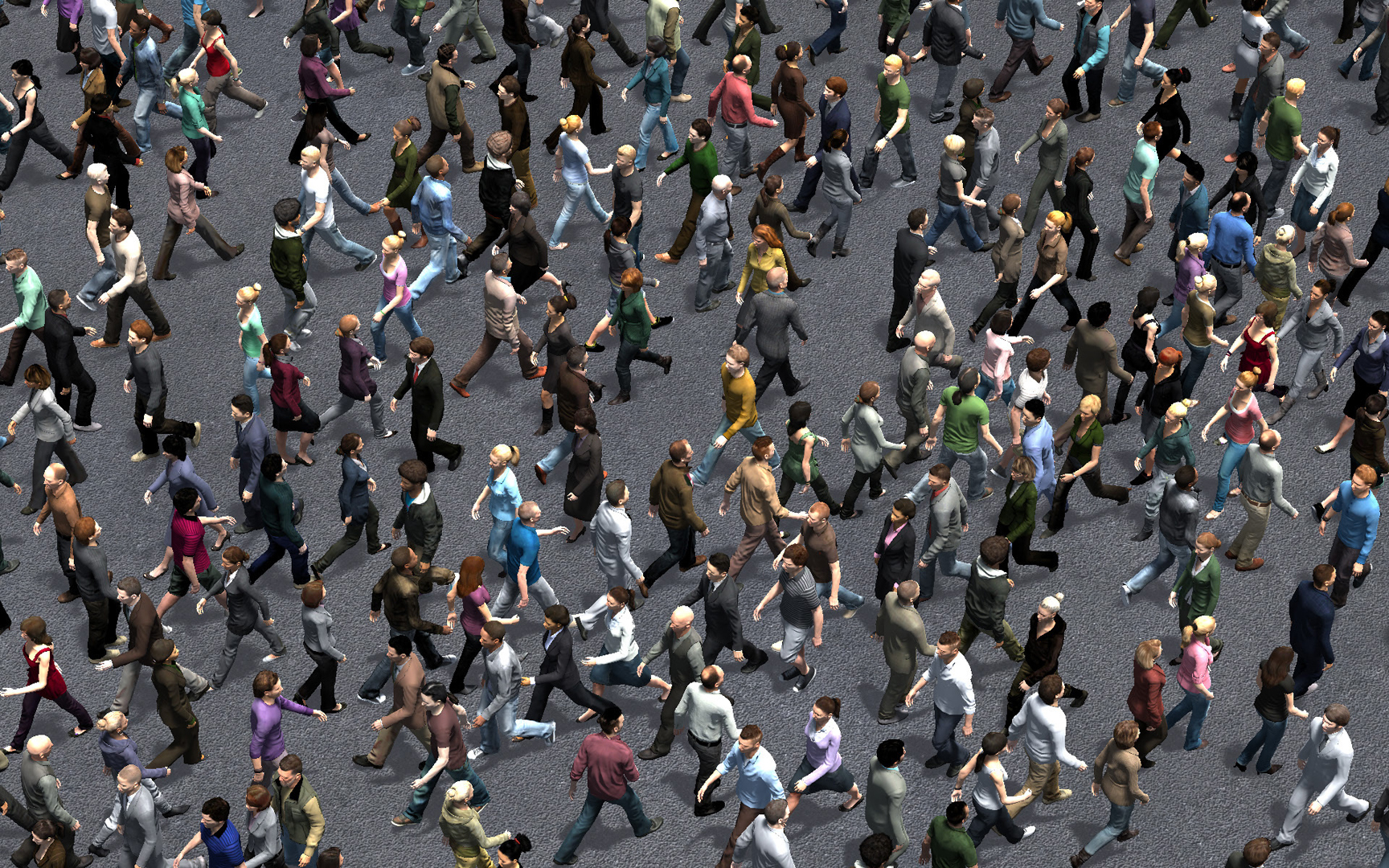“Perceptual effect of shoulder motions on crowd animations”
Conference:
Type(s):
Title:
- Perceptual effect of shoulder motions on crowd animations
Session/Category Title: PERCEPTION OF SHAPES AND PEOPLE
Presenter(s)/Author(s):
Moderator(s):
Abstract:
A typical crowd engine pipeline animates numerous moving characters according to a two-step process: global trajectories are generated by a crowd simulator, whereas full body motions are generated by animation engines. Because interactions are only considered at the first stage, animations sometimes lead to residual collisions and/or characters walking as if they were alone, showing no sign to the influence of others. In this paper, we investigate the value of adding shoulder motions to characters passing at close distances on the perceived visual quality of crowd animations (i.e., perceived residual collisions and animation naturalness). We present two successive perceptual experiments exploring this question where we investigate first, local interactions between two isolated characters, and second, crowd scenarios. The first experiment shows that shoulder motions have a strong positive effect on both perceived residual collisions and animation naturalness. The second experiment demonstrates that the effect of shoulder motions on animation naturalness is preserved in the context of crowd scenarios, even though the complexity of the scene is largely increased. Our general conclusion is that adding secondary motions in character interactions has a significant impact on the visual quality of crowd animations, with a very light impact on the computational cost of the whole animation pipeline. Our results advance crowd animation techniques by enhancing the simulation of complex interactions between crowd characters with simple secondary motion triggering techniques.
References:
1. Ennis, C., and O’Sullivan, C. 2012. Perceptually plausible formations for virtual conversers. Computer Animation and Virtual Worlds 23, 3-4, 321–329. Google ScholarDigital Library
2. Ennis, C., McDonnell, R., and O’Sullivan, C. 2010. Seeing is believing: Body motion dominates in multisensory conversations. ACM Trans. Graph. 29, 4 (July), 91:1–91:9. Google ScholarDigital Library
3. Helbing, D., and Molnár, P. 1995. Social force model for pedestrian dynamics. Physical Review E 51, 5, 4282–4286.Google ScholarCross Ref
4. Hoyet, L., McDonnell, R., and O’Sullivan, C. 2012. Push it real: Perceiving causality in virtual interactions. ACM Trans. Graph. 31, 4 (July), 90:1–90:9. Google ScholarDigital Library
5. Hughes, R., Ondřej, J., and Dingliana, J. 2014. Holonomic collision avoidance for virtual crowds. In Proceedings of the Symposium on Computer Animation, 103–111. Google ScholarDigital Library
6. Hughes, R. L. 2003. The flow of human crowds. Annual review of fluid mechanics 35, 1, 169–182.Google Scholar
7. Karamouzas, I., Skinner, B., and Guy, S. J. 2014. Universal power law governing pedestrian interactions. Phys. Rev. Lett. 113 (Dec), 238701.Google ScholarCross Ref
8. Kim, M., Hwang, Y., Hyun, K., and Lee, J. 2012. Tiling motion patches. In Proceedings of the Symposium on Computer Animation, 117–126. Google ScholarDigital Library
9. Korhonen, T., Heliövaara, S., Ehtamo, H., and Hostikka, S. 2009. Collision avoidance and shoulder rotation in pedestrian modeling. Tech. rep., Aalto University.Google Scholar
10. Kulpa, R., Olivier, A.-H., Ondřej, J., and Pettré, J. 2011. Imperceptible relaxation of collision avoidance constraints in virtual crowds. ACM Trans. Graph. 30, 6 (Dec.), 138:1–138:10. Google ScholarDigital Library
11. Kwon, T., and Shin, S. Y. 2005. Motion modeling for online locomotion synthesis. In Proceedings of the Symposium on Computer Animation, 29–38. Google ScholarDigital Library
12. Lee, J., Chai, J., Reitsma, P., Hodgins, J., and Pollard, N. 2002. Interactive control of avatars animated with human motion data. ACM Trans. Graph. 21, 3 (July), 491–500. Google ScholarDigital Library
13. Mäim, J., Yersin, B., and Thalmann, D. 2009. Unique character instances for crowds. IEEE Computer Graphics and Applications, 6, 82–90.Google ScholarCross Ref
14. McDonnell, R., Larkin, M., Dobbyn, S., Collins, S., and O’Sullivan, C. 2008. Clone attack! perception of crowd variety. ACM Trans. Graph. 27, 3 (Aug.), 26:1–26:8. Google ScholarDigital Library
15. McDonnell, R., Jörg, S., Hodgins, J., Newell, F., and O’Sullivan, C. 2009. Evaluating the effect of motion and body shape on the perceived sex of virtual characters. ACM Trans. Appl. Percept. 5, 4 (Feb.), 20:1–20:14. Google ScholarDigital Library
16. Ondřej, J., Pettré, J., Olivier, A.-H., and Donikian, S. 2010. A synthetic-vision based steering approach for crowd simulation. ACM Trans. Graph. 29, 4 (July), 123:1–123:9. Google ScholarDigital Library
17. Reitsma, P. S. A., and O’Sullivan, C. 2009. Effect of scenario on perceptual sensitivity to errors in animation. ACM Trans. Appl. Percept. 6, 3 (Sept.), 15:1–15:16. Google ScholarDigital Library
18. Reynolds, C. 1987. Flocks, herds and schools: A distributed behavioral model. SIGGRAPH Comp. Graphics 21, 4, 25–34. Google ScholarDigital Library
19. Rose, C., Cohen, M. F., and Bodenheimer, B. 1998. Verbs and adverbs: Multidimensional motion interpolation. IEEE Comput. Graph. Appl. 18, 5 (Sept.), 32–40. Google ScholarDigital Library
20. Shum, H. P. H., Komura, T., Shiraishi, M., and Yamazaki, S. 2008. Interaction patches for multi-character animation. ACM Trans. Graph. 27, 5 (Dec.), 114:1–114:8. Google ScholarDigital Library
21. Singh, S., Kapadia, M., Reinman, G., and Faloutsos, P. 2011. Footstep navigation for dynamic crowds. Computer Animation and Virtual Worlds 22, 2-3, 151–158. Google ScholarDigital Library
22. Stüvel, S. A., Magnenat-Thalmann, N., Thalmann, D., Egges, A., and van der Stappen, A. F. 2014. Hierarchical structures for collision checking between virtual characters. Computer Animation and Virtual Worlds 25, 3-4, 331–340. Google ScholarDigital Library
23. Stüvel, Magnenat-Thalmann, N., Thalmann, D., van der Stappen, A., and Egges, A. 2016. Torso crowds. IEEE Transactions on Visualization and Computer Graphics, 99.Google Scholar
24. Thalmann, D. 2007. Crowd simulation. Wiley Online Library. Google ScholarDigital Library
25. Treuille, A., Cooper, S., and Popović, Z. 2006. Continuum crowds. ACM Trans. Graph. 25, 3 (July), 1160–1168. Google ScholarDigital Library
26. Treuille, A., Lee, Y., and Popović, Z. 2007. Near-optimal character animation with continuous control. ACM Trans. Graph. 26, 3 (July). Google ScholarDigital Library
27. van den Berg, J., Lin, M., and Manocha, D. 2008. Reciprocal velocity obstacles for real-time multi-agent navigation. In IEEE Int. Conf. on Robotics and Automation, 1928–1935.Google Scholar
28. Yeh, T., Reinman, G., Patel, S., and Faloutsos, P. 2009. Fool me twice: Exploring and exploiting error tolerance in physics-based animation. ACM Trans. Graph. 29, 1, 5:1–5:11. Google ScholarDigital Library





